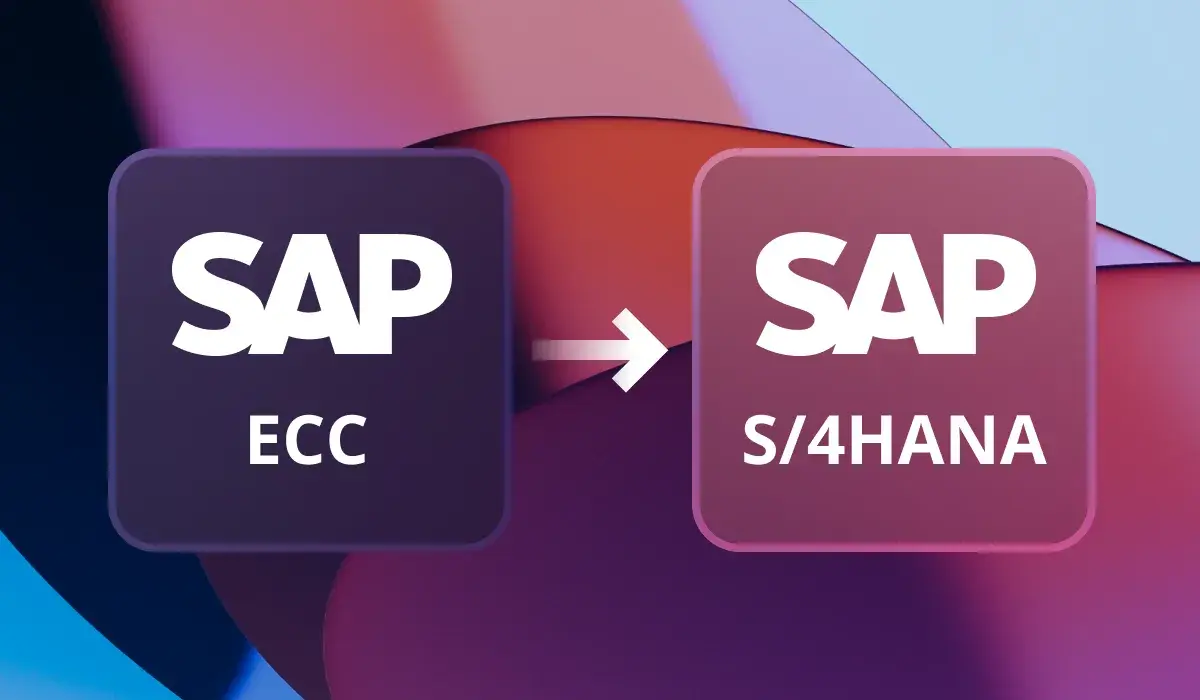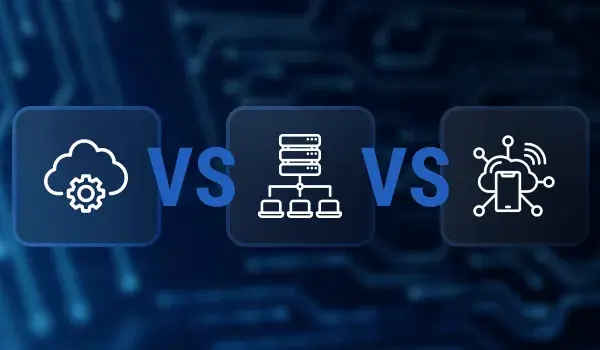The question is how can your business prepare for SAP S/4HANA implementation and which deployment approach should you choose: on-premise, cloud, or hybrid? Let’s find out which edition will meet all your business needs.
Every business aims to make its processes more efficient, and implementing a modern ERP system is a big step toward achieving that goal. One of the top players in the ERP market is SAP S/4HANA, an innovative system designed to automate and streamline critical operations, from finance to supply chains.
SAP S/4HANA gives businesses the flexibility to choose how they deploy the system: On-Premise, Cloud, or hybrid. On-premise is installed on the company’s own servers, the cloud is hosted online, and the hybrid model combines both approaches. Each option comes with its own set of benefits, challenges, and unique features, depending on your company’s goals, resources, and overall strategy.
The question is how can your business prepare for SAP S/4HANA implementation and which deployment approach should you choose: on-premise, cloud, or hybrid? Let’s find out which edition will meet all your business needs.
Who Should Choose SAP S/4HANA On-Premise Edition?
SAP S/4HANA On-Premise is suitable for large manufacturing enterprises. In this case, their business industry doesn’t matter; the main thing is well-established internal processes that do not need to be changed. This ERP system version gives you complete control over hardware, software, and maintenance schedules.
SAP S/4HANA On-Premise is an excellent option for businesses that want to achieve maximum process flexibility and seamless integration with third-party systems. It is also good for those enterprises that already use SAP ECC and want to migrate to SAP S/4HANA due to the discontinuation of support for the former version in 2027.
The on-premise deployment model is best for businesses that want to manage their entire IT landscape or require keeping the business application in close proximity to other parts of their organization. You can also choose an on-premise model if you have strict rules governing access to your data and not allowing employees to have access to your systems outside the company.
If your business relies on unique processes and has strict security requirements, it’s worth exploring the specifics, benefits, and challenges of deploying SAP S/4HANA On-Premise.
Who Should Choose SAP S/4HANA Cloud Edition?
SAP S/4HANA Cloud is the SaaS version of S/4HANA. It means you get access to most of the SAP S/4HANA On-Premise features without spending money on special equipment, databases, and IT specialists to maintain them. It also allows you to benefit from the use of SAP Business Technology Platform and SAP Business Network.
The cloud version is suited for medium businesses in the active growth phase that want to build their processes on a scalable platform. Such a system will grow with the company, providing the business with required solutions, flexibility, and quarterly updates.
Two options are possible with SAP S/4HANA Cloud implementation: Private and Public Cloud.
SAP S/4HANA Private Cloud
SAP S/4HANA Private Cloud is an on-premise deployment in a secure private cloud. In this case, SAP acts as a cloud service provider that manages the infrastructure and software. This SAP implementation scenario means that the customer must agree upon all update schedules. SAP S/4HANA Private Cloud also allows for a specific system modification level. However, this feature will require additional financial costs due to the increased complexity of management.
SAP S/4HANA Public Cloud
SAP S/4HANA Public Cloud operates in a shared cloud environment fully managed by SAP. As part of a shared system, this version does not allow for software customization. However, it benefits from regular updates by SAP, which follow a set schedule without client input.
If the speed of implementation, easy scalability, and cost reduction are top priorities for your business, explore SAP S/4HANA Public Cloud.
SAP S/4HANA cloud supports core business processes across finance, marketing, and production. Designed as a simplified system, it offers a shorter implementation timeline compared to more complex ERP solutions.
SAP S/4HANA Hybrid Model: The Best of Both Worlds
The hybrid model combines the possibilities of cloud and on-premise editions to accelerate business transformation and reduce IT infrastructure costs while maintaining system reliability.
With a hybrid implementation, you can run some business transactions locally (such as finance, inventory, and manufacturing) and others (such as customer relationship management) in the cloud.
The hybrid model is also suitable for companies with a divisional management structure. In this case, SAP S/4HANA On-premise can be deployed to your headquarters and the cloud edition to your branches.
Migrating to SAP S/4HANA: Success Stories from LeverX
Eurasia Group Kazakhstan’s Migration to SAP S/4HANA
Eurasia Group Kazakhstan, a key partner of John Deere in Kazakhstan and Kyrgyzstan, has been helping local farmers adopt advanced technologies for over 20 years. However, their outdated ERP system, SAP ECC, started to slow down operations. It became clear that change was necessary. The company made the decision to migrate to SAP S/4HANA.
In just 8.5 months, the Eurasia Group team, with the support of LeverX experts, successfully transitioned key business processes to the new platform, upgraded functionality, and prepared the system for full-scale operation.
As a result, the client reduced maintenance costs by 10%, sped up data processing, and made the system more intuitive and user-friendly, thanks to SAP Fiori interfaces.
SAP S/4HANA On-Premise Deployment and Upgrade for a European Construction Group
LeverX partnered with a European group of construction companies to bring their business operations to the next level. Our experts enhanced the functionality of their existing SAP system and implemented SAP S/4HANA from scratch for another company within the group. The project covered critical modules like FI, CO, MM, SD, and others, upgrading the system to the 2020 version and providing post-project support.
Thanks to SAP S/4HANA, the organization achieved process automation, enhanced visibility across value chains, and reduced IT costs through outsourcing.
Unifying Business Processes with SAP S/4HANA
Scattered systems, manual Excel planning, piles of paper reports moving from one department to another, errors, and confusion — this was the daily reality for a major auto parts manufacturer.
To optimize their operations, the client partnered with LeverX. Our project team began by analyzing the company's processes to pinpoint weaknesses and identify areas for improvement. This thorough assessment revealed that implementing SAP S/4HANA was a promising solution for the client.
With this ERP system, the company achieved seamless operation synchronization, automated task execution, and real-time data collection. The new system brought everything together—from production to finance.
The warehouse went from chaotic to organized, with streamlined logistics and inventory levels perfectly aligned to production needs. Production automation shortened cycles and reduced waste, freeing managers from manually recalculating weekly plans. Financial operations also became effortless, with everything handled automatically and with precision.
Key outcomes in numbers:
- 4% faster production cycles
- 10% reduction in profit losses
- Up to 5% increase in on-time deliveries
- 96% automation of bank statement processing
- 0.1–0.5% decrease in production costs
- 10–20% boost in employee engagement
- 3% reduction in inventory storage time
SAP S/4HANA On-Premise vs. Cloud vs. Hybrid — Which is Right for You?
Comparing the three editions of SAP S/4HANA is like weighing the security of your own home against the convenience and flexibility of cloud technology. The right choice depends on your company’s goals, resources, and business size. Let’s break down the key factors that can help you decide:
On-Premise, Cloud, or Hybrid Edition: What’s the Difference?
| On-Premise Edition | Cloud Edition | Hybrid Edition | |
| Licensing model | Traditional licensing. | Subscription. | Some licenses for on-premise modules, others by subscription. |
| Cost (implementation) | It is more costly because of functional scope, project duration, and the need for additional hardware and/or software. | The price is comparatively lower. | Medium-level costs: The price depends on the mix of cloud and on-premise modules. |
| Implementation time | On-premise version requires more cost and time (because of additional hardware or software) and qualified personnel to build a new environment. | Shorter due to the ready-made platform used by the cloud version. | Faster than on-premise, but slower than cloud. |
| Functional scope | Full ERP scope. | Key industrial and embedded ERP scenarios. | A mix of on-premise functionality for critical tasks on-premise and cloud for standard processes. |
| Customization | Due to system flexibility, there are many opportunities for customization. | Customers have full access to the on premise extensibility framework, supporting in-app and side-by-side extensions in addition to code enhancement and modifications. Expert configuration is possible with full IMG (Implementation Guide) access, and the operating expense model is subscription-based. |
Flexibility in the on-premise part of the system, with minimal configuration in the cloud. |
| Scalability | Long-term planning and extra resources are required. | To scale the system up or down is easier, faster, and cheaper. | Allows for gradual scaling of cloud functions while maintaining the stability of on-premise infrastructure. |
| Upgrades | You decide how often to upgrade your system and define the schedule of software upgrades in case your business processes require new SAP features and innovations. | You have less control over system upgrades. Your provider informs you about the impending upgrades in advance, and you can choose the timing and functionality. New SAP features are released every six months. |
The on-premise part is upgraded at the client’s discretion, while the provider updates the cloud. |
| Maintenance, support | The system is supported by in-house IT specialists. | The provider is responsible for the system maintenance. | The on-premise part is supported by the client’s IT department, while the cloud is supported by the provider. |
| Infrastructure | Customer's Hardware. | SAP Data Center or Hyperscale. | Some data is stored locally, while some is in the cloud. |
| Who manages the system | Customer. | Provider. | Critical modules are managed by the client, while others are handled by the provider. |
| Security | You need security experts and often additional security software to support on-premise system security. | The provider has all the required tools to ensure the customer's system security. | The on-premise part is protected by the client's internal team, while cloud security is managed by the provider. |
If your company values full control, requires deep customization and is ready to invest in infrastructure, SAP S/4HANA On-Premise is the right choice for you.
If you’re looking for flexibility, quick implementation, and minimal IT costs, then a cloud solution is the way to go.
A hybrid approach is the best option for organizations with varying needs across different regions or departments.
Note: Your decision should reflect not only your current needs but also align with your company’s long-term strategy. LeverX consultants are here to help you find the perfect solution.
In a Nutshell
Choosing the right SAP S/4HANA implementation model will help you achieve your specific business goals. The LeverX team consists of highly qualified experts whose experience and knowledge allow them to handle any tasks, from system analysis to its implementation and post-launch support. LeverX helps businesses adapt to modern challenges and offers a full spectrum of services, including:
- SAP Implementation: End-to-end SAP solution implementation
- SAP in Cloud: Business process migration to the cloud
- SAP S/4HANA Private Cloud: Custom solutions for private cloud
- SAP S/4HANA Public Cloud: Pre-developed cloud solution for a quick start
Contact us for a personalized consultation with LeverX experts. Together, we’ll choose the strategy that will work best for your business.
How useful was this article?
Thanks for your feedback!



